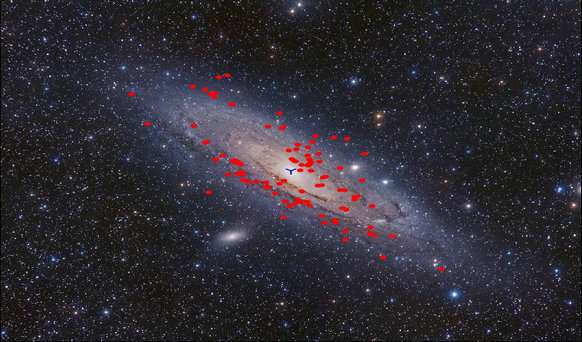Using LAMOST spectra data to propose new method to search for star clusters in Andromeda galaxy

Making use of the LAMOST spectra data as the training sample, a research team led by Dr. Wang Shoucheng and Prof. Ma Jun from National Astronomical Observatories of Chinese Academy of Sciences (NAOC) proposed a new method to search for star clusters in the Andromeda galaxy.
With this method, the researchers identified 117 new high-confidence cluster candidates in the Andromeda galaxy based on the Pan-Andromeda Archaeological Survey (PAndAS) data, among which 109 are young cluster candidates located in the disk, and eight are old globular clusters in the outer halo.
The study was published in Astronomy & Astrophysics.
Star clusters are widely distributed throughout the galaxy from the bulge and disk to the outer halo, providing an excellent tool for revealing the early formation and evolutionary history of galaxies.
The Andromeda Galaxy, also known as Messier 31 (M31), is the closest large spiral galaxy to our Milky Way, and is an ideal laboratory to study galaxy formation and evolution.
Astronomers have long been working on the identification of star clusters in M31 to obtain a complete cluster sample of this galaxy. Recent wide-field photometric and spectroscopic surveys have provided a good opportunity to search for M31 clusters. However, to find and identify the special objects we need from tens of millions of images obtained by the deep wide-field photometric surveys is difficult at present.
By selecting 346 M31 clusters, as well as Galactic foreground objects and background galaxies, from the LAMOST DR6 database, and combining with the cluster and non-cluster samples in M31 obtained from the literature as training samples, the researchers constructed a class of two-channel deep convolutional neural network (CNN) model to identify star clusters. Its accuracy has been proved to be able to achieve 99% in the test set. Using this model, the researchers identified 117 new high-confidence M31 cluster candidates from more than 21 million images obtained by the PAndAS photometric survey.
A more complete M31 star cluster sample is a valuable reference for further study on the formation and evolution of M31. "The automatic detection of star clusters in large sky surveys is in urgent demand considering the forthcoming wide field large aperture facilities, and the CNN model proposed by this work is very timely," said Dr. Wang.
"This method can also be generated to a wider range of applications. For example, it is helpful to identify gravitational lenses and search for high redshift galaxies," said Prof. Ma.
More information: Shoucheng Wang et al, Identification of new M 31 star cluster candidates from PAndAS images using convolutional neural networks, Astronomy & Astrophysics (2021). DOI: 10.1051/0004-6361/202142169
Journal information: Astronomy & Astrophysics
Provided by Chinese Academy of Sciences



















